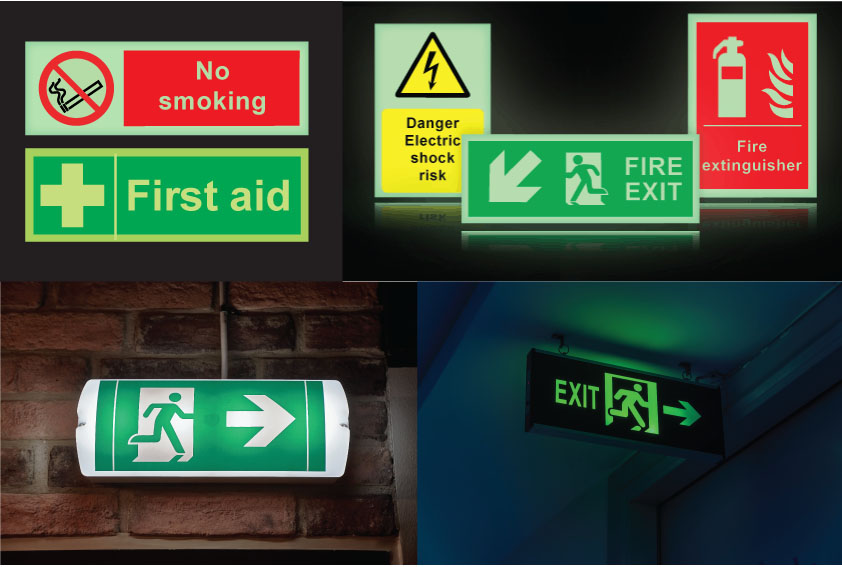
More than simply being an annoyance, power outages can become a real hazard, especially in areas which have convoluted layouts, increased foot traffic, or dangerous materials.
In the interest of efficient evacuation and quick response in case of emergency, building managers should ensure good visibility during a power failure, no matter if they’re in charge of a commercial building, office, warehouse, or laboratory.
Photoluminescent safety signs, which can be seen clearly in the dark, are a key element of that. Here, we’ll outline the essential signage each building needs, any specific regulations, and the unique requirements for certain building types.
What Does Photoluminescent Mean?
Put simply, photoluminescent materials are things which can absorb ambient light (from daylight or artificial lights) and store it, ready to emit in low light or darkness.
The value of photoluminescent safety signs comes from the guidance they can provide during a power outage, illuminating key routes and areas without the need for an electrical supply.
Photoluminescent Fire Exit Signs Regulations
There are various photoluminescent fire exit signs regulations UK building owners and employers must follow. Directives such as the Health and Safety (Safety Signs and Signals) Regulations 1996 and the Regulatory Reform (Fire Safety) Order 2005 highlight the importance of having fire exits, routes for evacuation, and fire equipment clearly marked with signs which are visible at all times, including in dim light (or when obscured by smoke).
That’s where photoluminescent safety signs come in. Since they don’t rely on batteries or external lights, they’re the best way to ensure fire safety signs can be identified quickly and followed to safety. This is especially crucial in facilities where hazardous materials are stored or in large buildings with complicated floor plans.
A Photoluminescent Safety Signs Checklist
Fire Exit Signage
No matter the purpose of your building or its size, you are legally required to install fire exit signs to guide people safely out of the building. Photoluminescent fire exit signs are an ideal choice, since they glow in the dark and will be able to mark an exit route even in the event of a power failure.
Fire Equipment Signs
In a similar vein, it’s also important that anyone in the building can easily locate basic fire-fighting equipment in case of emergency, even when the lights are out. Photoluminescent safety signs marking fire extinguishers, fire hose reels, and fire alarms can aid responders in quickly accessing these tools and taking action.
Directional Markings
In certain settings, such as large buildings or more complex environments like a warehouse, just having signs for the fire exits isn’t sufficient – you need to mark the route to get there too.
Kitting out hallways and stairways with photoluminescent directional arrows and floor tape can be particularly handy in a blackout, when it’s even harder to navigate a jumbled building layout.
Hazard Warnings
High-risk zones housing electrical cabinets, dangerous chemicals, or heavy machinery are another area you should take care to mark – and make sure it’s still visibly signposted in pitch-dark conditions.
Having photoluminescent safety signs highlighting these sections and issuing instructions (such as “This area must be kept clear at all times” or “Radiation risk”) is an effective way to reinforce caution.
Specialist Photoluminescent Safety Signs for Warehouses, Labs, and Marine Facilities
While basic safety sign regulations apply to most buildings, some more specialist environments have extra boxes to tick when it comes to signage.
For example, laboratories which house hazardous chemicals should have photoluminescent safety signs indicating these dangers, along with labels signposting the emergency shower and emergency eye wash, in case an accident occurs during – or just before – a power outage.
It is also sensible to include photoluminescent signs to indicate combustible substances, in case of fire.
Similarly, in warehouses or workshops, there should be glow-in-the-dark emergency stop signs for any large machinery, plus a detailed fire action notice to help avoid employees getting into dangerous situations.
Specialist marine facilities are also subject to International Maritime Organisation (IMO) guidelines, meaning commercial vessels are required to display a series of mandatory IMO photoluminescent safety symbols.
Stay Safe and Compliant with Photoluminescent Safety Signs from Label Source
Even if you can’t predict power outages, you can plan ahead to ensure your building is fitted with all the essential signage to ensure maximum safety in the event of power failure.
Browse our range of photoluminescent safety signs for all the key items you’d need to meet safety requirements and prepare for emergencies.
Whether you’re in charge of an office, another commercial building, or a more specialist building (such as a laboratory, warehouse, or even a marine vessel), we can support you with cost-effective signage solutions.
Not seeing what you need? Contact us and we’ll be happy to assist you.